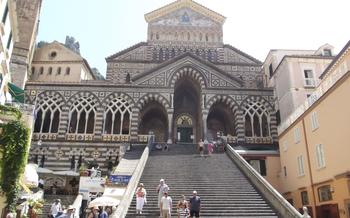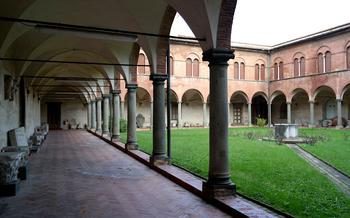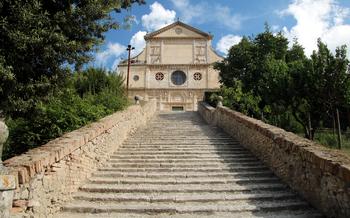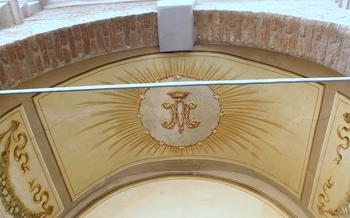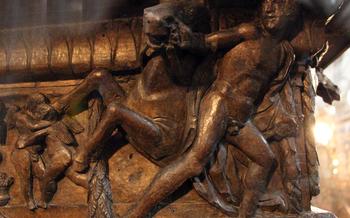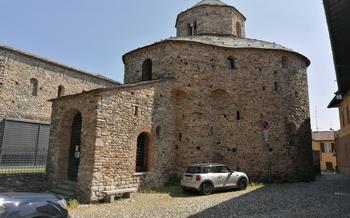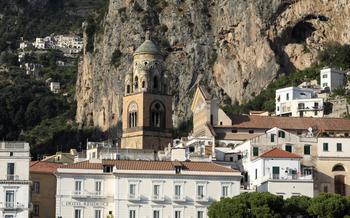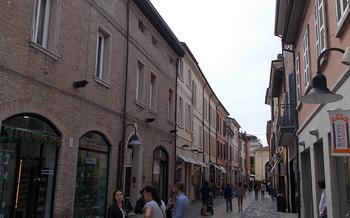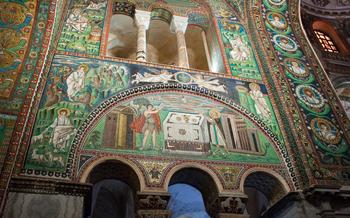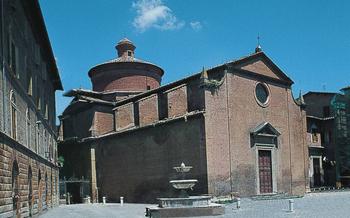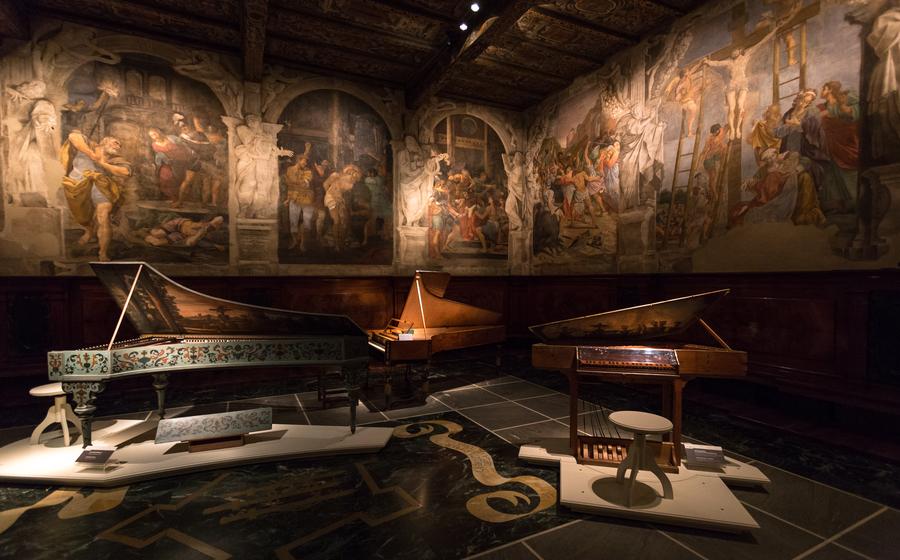
Oratorio di San Colombano
- The Oratorio di San Colombano: A Timeless Masterpiece in the Heart of Bologna
- Historical Context
- Architecture and Design
- Interior Decorations
- Artistic Importance
- Historical Figures
- Religious Significance
- Restoration and Preservation
- Visiting Information
- Guided Tours
- Photography and Videography
- Nearby Attractions
- Local Food and Wine
- Insider Tip: A Hidden Gem Revealed
The Oratorio di San Colombano: A Timeless Masterpiece in the Heart of Bologna
In the heart of Bologna, Italy, lies a hidden gem that transports visitors back to the Middle Ages – the Oratorio di San Colombano. This extraordinary oratory, with its rich history, stunning architecture, and intricate frescoes, offers a glimpse into the city's glorious past.
- History of the Oratorio di San Colombano:
- Dating back to the 8th century, the Oratorio di San Colombano was built by Benedictine monks as a place of worship and prayer.
-
Its construction marked a significant period in Bologna's history, as the city emerged as a center of learning and culture.
-
Location of the Oratorio di San Colombano:
-
Nestled in the historic center of Bologna, the oratory is conveniently located near the Piazza Maggiore, making it easily accessible to visitors exploring the city.
-
Architectural Style of the Oratorio di San Colombano:
- The Oratorio di San Colombano showcases a harmonious blend of Gothic and Romanesque architectural styles, reflecting the transition between these two influential periods.
-
Its exterior features simple, elegant lines, while the interior boasts intricate carvings and decorative elements.
-
Artistic Significance of the Oratorio di San Colombano:
- The oratory is renowned for its stunning frescoes, particularly those by the renowned artist Lippo di Dalmasio.
- These frescoes, depicting biblical scenes and figures, are considered masterpieces of the Gothic period and draw art enthusiasts from around the world.
Historical Context
In the 8th century, Bologna was a thriving city, gaining political and economic power. During this period, the Benedictine monks played a significant role in the city's religious and cultural development. They established monasteries and churches, contributing to the spread of Christianity and the preservation of knowledge.
The Oratorio di San Colombano was constructed during this time of religious fervor and intellectual growth. The Benedictine monks, dedicated to the pursuit of spirituality and learning, sought to create a sacred space for worship and contemplation. The Oratorio, with its intricate architecture and symbolic decorations, became a testament to their devotion and artistic prowess.
As Bologna evolved into a center of learning and culture, the Oratorio di San Colombano stood as a symbol of the city's rich spiritual heritage. It became a place where scholars, artists, and religious figures gathered to exchange ideas, fostering an environment of intellectual and spiritual growth.
The Oratorio's historical significance is deeply intertwined with the development of Bologna as a prominent city in the region. Its construction reflects the religious and cultural influences that shaped the city during the 8th century, leaving a lasting legacy that continues to inspire visitors to this day.
Architecture and Design
The Oratorio di San Colombano stands as a testament to the architectural ingenuity of its time. Its exterior facade exudes an air of simplicity, adorned with elegant arches and delicate carvings that hint at the artistic treasures within. Step inside, and you'll be greeted by a harmonious blend of Gothic and Romanesque styles, creating a captivating visual narrative.
The ribbed vaults soar overhead, supported by slender columns that lend a sense of lightness and grace to the interior. The pointed arches, characteristic of Gothic architecture, create a sense of height and majesty, drawing your gaze upwards. Intricate carvings and decorative elements adorn the walls, telling stories from the Bible and the lives of saints, adding depth and meaning to the sacred space.
One of the most striking features of the Oratorio di San Colombano is its intricate rose window. Located above the entrance, this masterpiece of stained glass artistry depicts scenes from the life of Jesus Christ. The vibrant colors and delicate craftsmanship of the window create a mesmerizing effect, casting a warm glow on the interior.
The Oratorio di San Colombano is not just a place of worship but also a testament to the artistic and architectural achievements of Bologna during the Middle Ages. Its unique blend of styles and its exquisite decorations make it a must-see for anyone interested in the history of art and architecture.
Interior Decorations
Explore the intricate decorations inside the Oratorio di San Colombano, focusing on the frescoes and other art forms.
The interior of the Oratorio di San Colombano is a testament to the artistic prowess of the Middle Ages. The walls are adorned with stunning frescoes by Lippo di Dalmasio, a renowned painter from the Sienese School. These frescoes depict scenes from the life of Saint Columbanus, the patron saint of the oratory, as well as other biblical stories. The vibrant colors and expressive figures bring the stories to life, creating a sense of awe and wonder for visitors.
In addition to Lippo di Dalmasio's frescoes, the oratory is adorned with other notable frescoes and paintings. The apse features a fresco of the Madonna and Child Enthroned, surrounded by angels. The walls of the nave are decorated with scenes from the life of Jesus Christ, including the Nativity, the Crucifixion, and the Resurrection. These frescoes are characterized by their delicate brushwork and attention to detail, showcasing the skill and artistry of the medieval painters.
The iconography of the frescoes and paintings is rich in symbolic meanings. Each scene conveys a specific message or lesson, often related to the Christian faith. The depictions of saints and angels represent the heavenly realm, while the scenes from the life of Christ symbolize his sacrifice and redemption. The overall effect is a visually stunning and spiritually uplifting experience for visitors, who are invited to contemplate the deeper meanings behind the artwork.
Through meticulous restoration and preservation efforts, the interior decorations of the Oratorio di San Colombano have been meticulously preserved, ensuring that future generations can continue to appreciate their beauty and significance.
Artistic Importance
The Oratorio di San Colombano stands as a testament to the artistic and cultural flourishing of Bologna during the Middle Ages. Its architectural design, intricate frescoes, and symbolic iconography make it a significant example of Gothic and Romanesque art. The Oratorio's unique blend of artistic styles, influenced by Byzantine and Early Christian traditions, showcases the transition from the Romanesque to the Gothic era.
The frescoes within the Oratorio, attributed to the renowned artist Lippo di Dalmasio, are particularly noteworthy. These vibrant and expressive paintings depict biblical scenes and saints, capturing the emotional intensity and religious fervor of the period. The symbolic iconography employed in the frescoes carries deep theological and moral messages, inviting viewers to contemplate the spiritual and earthly realms.
The Oratorio di San Colombano's artistic significance extends beyond its individual features. It served as a model and inspiration for numerous other religious buildings in Bologna and the surrounding region, leaving a lasting impact on the development of Italian art. The Oratorio's influence can be seen in the decorative elements, architectural forms, and iconographic programs of subsequent churches and religious structures.
Moreover, the Oratorio's artistic legacy has been recognized and celebrated by art historians and enthusiasts worldwide. Its inclusion in prestigious art publications, exhibitions, and travel guides has solidified its position as a must-visit destination for those interested in medieval art and architecture. The Oratorio di San Colombano continues to captivate visitors with its artistic beauty, historical significance, and enduring spiritual aura.
Historical Figures
Among the notable historical figures associated with the Oratorio di San Colombano is Petronius, Bishop of Bologna. He played a pivotal role in the construction and development of the oratory. During his tenure as bishop in the 5th century, Petronius dedicated himself to promoting Christianity and establishing religious institutions in Bologna. He is credited with initiating the construction of the Oratorio di San Colombano, which was initially a small chapel dedicated to the saint.
Over the centuries, the oratory underwent several modifications and expansions, reflecting the changing needs of the growing Christian community in Bologna. Petronius's vision and dedication laid the foundation for the oratory's transformation into the significant religious and artistic landmark it is today. Other notable figures associated with the Oratorio di San Colombano include cardinals, bishops, and scholars who contributed to its history and significance. Their influence can be seen in the artwork, architecture, and ongoing preservation efforts that maintain the oratory's grandeur and spiritual essence.
Religious Significance
The Oratorio di San Colombano holds immense religious significance as a place of worship for the Catholic Church. Built as a private chapel for the Benedictine monks of the San Colombano monastery, it served as a spiritual sanctuary for the monastic community. Masses, prayers, and religious ceremonies were regularly held within its walls, fostering a deep sense of devotion among the monks and the wider community.
Throughout the centuries, the Oratorio di San Colombano has played a pivotal role in the religious life of Bologna. It became a popular destination for pilgrims and worshippers seeking spiritual guidance and solace. The presence of the relics of Saint Columbanus, a revered Irish missionary, further enhanced the Oratorio's reputation as a holy site.
Today, the Oratorio di San Colombano continues to be an active place of worship, welcoming both locals and visitors seeking a sacred space for prayer and contemplation. It hosts regular masses, special services, and religious festivals, drawing believers from across the region. The Oratorio's enduring religious significance is a testament to its enduring role in the spiritual fabric of Bologna.
Restoration and Preservation
The Oratorio di San Colombano, a testament to Bologna's rich history and artistic heritage, has undergone several restoration and preservation efforts to maintain its integrity and beauty. The passage of time, natural elements, and human interventions have posed challenges in preserving the Oratorio's intricate frescoes and architectural features.
Experts in the field of restoration have employed meticulous techniques to restore the Oratorio's original splendor. Careful cleaning methods have removed centuries of dirt and grime, revealing the vibrant colors and details of the frescoes. Structural reinforcement has been implemented to ensure the stability of the building, preserving its architectural integrity.
The restoration process has been guided by a deep understanding of the Oratorio's historical significance and artistic value. Conservators have strived to maintain the authenticity of the original artwork while addressing the effects of aging and environmental factors.
The successful restoration and preservation of the Oratorio di San Colombano stand as a testament to the dedication and expertise of those involved in its care. Their efforts have ensured that future generations can continue to appreciate the beauty and significance of this architectural and artistic masterpiece.
Visiting Information
Opening Hours and Days: The Oratorio di San Colombano welcomes visitors from Tuesday to Sunday throughout the week. It remains closed on Mondays, allowing for maintenance and preservation activities. The opening hours on weekdays are from 10 AM to 1 PM and 3 PM to 6 PM. On Saturdays, the Oratorio extends its hours from 10 AM to 6 PM without a midday break, providing more flexibility for weekend visits. Sundays follow a slightly shorter schedule, opening from 1 PM to 6 PM.
Admission Fees and Ticketing Information: Admission to the Oratorio di San Colombano is free of charge, offering visitors the opportunity to immerse themselves in its artistic and historical treasures without any financial barriers. This open access policy encourages cultural exploration and learning for all, making it an inclusive destination for locals and tourists alike.
Accessibility Features: The Oratorio di San Colombano is committed to accessibility, ensuring that visitors with disabilities can fully experience its wonders. The entrance is equipped with ramps to accommodate wheelchairs and strollers, providing seamless access to the ground floor. Additionally, audio guides are available for a more immersive experience, catering to the needs of visually impaired visitors.
Tips for Planning a Visit: To make the most of your visit to the Oratorio di San Colombano, consider these helpful tips: - Avoid Peak Hours: If possible, plan your visit during non-peak hours, typically in the morning or late afternoon, to avoid crowds and fully appreciate the Oratorio's serene atmosphere. - Allow Ample Time: Set aside at least 30 minutes to an hour to explore the Oratorio. This will give you sufficient time to admire the frescoes, study the architectural details, and soak in the ambiance of this historic site. - Bring Comfortable Shoes: The Oratorio's floors are uneven, so comfortable footwear is recommended to ensure a safe and enjoyable visit. - Capture the Moment: Photography is permitted inside the Oratorio, allowing you to capture your memories. However, remember to be respectful of other visitors and avoid using flash photography.
Guided Tours
Guided tours of the Oratorio di San Colombano offer an immersive experience, allowing visitors to delve into the rich history, art, and spiritual significance of this sacred space. Knowledgeable guides provide insightful commentary, unraveling the stories behind the exquisite frescoes and architectural details. Visitors can gain a deeper understanding of the Oratorio's unique characteristics, including its Gothic and Romanesque influences and its role in Bologna's religious and cultural heritage.
Guided tours are available in various languages and cater to different interests. Standard tours provide a comprehensive overview of the Oratorio's history and artistic highlights, while specialized tours may focus on specific themes, such as the iconography of the frescoes or the Oratorio's role in the development of Gothic art. Visitors can choose a tour that best suits their interests and knowledge level.
Booking a guided tour in advance is recommended to secure a spot, especially during peak tourist seasons. Fees vary depending on the type of tour and the number of participants. Guided tours offer an enriching experience, allowing visitors to fully appreciate the Oratorio di San Colombano's beauty and significance while gaining valuable insights into its history and artistic legacy.
Photography and Videography
The Oratorio di San Colombano welcomes photography and videography enthusiasts to capture the beauty of its sacred spaces. However, certain guidelines must be respected to ensure the preservation of the artwork and the tranquility of other visitors.
Photography and videography are permitted in the Oratorio, but the use of flash photography and tripods is strictly prohibited. These restrictions aim to protect the delicate frescoes and paintings from potential damage caused by excessive light exposure and vibrations.
Commercial photography and videography projects are allowed with prior permission from the relevant authorities. Please contact the Oratorio's administration to inquire about obtaining the necessary permits and permissions for commercial purposes.
While capturing the Oratorio's beauty through photography and videography, it is crucial to be mindful of other visitors and avoid disrupting their spiritual experience or privacy. Respectful conduct and consideration for fellow visitors are essential to maintain a serene atmosphere within the Oratorio.
Nearby Attractions
In the vicinity of the Oratorio di San Colombano, Bologna offers a treasure trove of additional attractions that enrich any visit. For history enthusiasts, the Basilica di Santo Stefano stands as a testament to Bologna's rich past, featuring a complex of interconnected churches that span various architectural periods. Piazza Maggiore, the heart of Bologna's historic center, boasts iconic landmarks like the Palazzo d'Accursio, the Basilica di San Petronio, and the Fontana del Nettuno. Art lovers will find solace in the Pinacoteca Nazionale di Bologna, housing masterpieces by renowned Italian artists like Raffaello Sanzio and Caravaggio.
For those seeking a sensory experience, Bologna's culinary scene beckons with its delectable offerings. Indulge in a plate of tagliatelle al ragù, a Bolognese specialty, or savor the divine mortadella, a cured meat that has earned global acclaim. Pair your meal with a glass of Lambrusco, a local sparkling wine that perfectly complements the city's flavors.
Craft a personalized itinerary that seamlessly blends culture and cuisine, exploring the Oratorio di San Colombano alongside Bologna's other gems. Discover hidden corners, unravel captivating stories, and create lasting memories in this enchanting city.
Local Food and Wine
A visit to Bologna is not complete without indulging in the city's rich culinary traditions. When planning your itinerary, allocate time to savor the local delicacies that have earned Bologna its reputation as a food lover's paradise. Traditional dishes such as tagliatelle al ragù, a pasta dish featuring homemade tagliatelle noodles tossed in a slow-cooked meat sauce, are a must-try.
Pair your meal with a glass of regional wine, such as Sangiovese or Lambrusco, to enhance the flavors of the local cuisine. For an authentic dining experience, venture into the narrow streets of Bologna and seek out traditional trattorias or osterias. These family-run establishments offer a warm atmosphere and serve up hearty, comforting dishes that showcase the region's culinary heritage.
Consider incorporating a food tour into your Bologna itinerary to discover hidden gems and learn about the history and culture behind the local cuisine. These tours often visit local markets, artisan food shops, and trattorias, allowing you to sample a variety of specialties and interact with passionate food enthusiasts.
Insider Tip: A Hidden Gem Revealed
Beyond the visible splendor of the Oratorio di San Colombano lies a hidden gem that often goes unnoticed. Within the intricate frescoes adorning the walls, there exists a subtle yet captivating detail that holds a special significance. Look closely for a small, unassuming bird perched atop a tree branch. This seemingly insignificant creature is believed to be a symbol of hope and renewal, a reminder that even in the midst of adversity, there is always the potential for new beginnings. Discover this hidden treasure during your visit to the Oratorio di San Colombano, and let its symbolism inspire you to embrace life's challenges with optimism and resilience.
